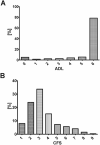The association of the Activities of Daily Living and the outcome of old intensive care patients suffering from COVID-19
- PMID: 35303201
- PMCID: PMC8931579
- DOI: 10.1186/s13613-022-00996-9
The association of the Activities of Daily Living and the outcome of old intensive care patients suffering from COVID-19
Abstract
Purpose: Critically ill old intensive care unit (ICU) patients suffering from Sars-CoV-2 disease (COVID-19) are at increased risk for adverse outcomes. This post hoc analysis investigates the association of the Activities of Daily Living (ADL) with the outcome in this vulnerable patient group.
Methods: The COVIP study is a prospective international observational study that recruited ICU patients ≥ 70 years admitted with COVID-19 (NCT04321265). Several parameters including ADL (ADL; 0 = disability, 6 = no disability), Clinical Frailty Scale (CFS), SOFA score, intensive care treatment, ICU- and 3-month survival were recorded. A mixed-effects Weibull proportional hazard regression analyses for 3-month mortality adjusted for multiple confounders.
Results: This pre-specified analysis included 2359 patients with a documented ADL and CFS. Most patients evidenced independence in their daily living before hospital admission (80% with ADL = 6). Patients with no frailty and no disability showed the lowest, patients with frailty (CFS ≥ 5) and disability (ADL < 6) the highest 3-month mortality (52 vs. 78%, p < 0.001). ADL was independently associated with 3-month mortality (ADL as a continuous variable: aHR 0.88 (95% CI 0.82-0.94, p < 0.001). Being "disable" resulted in a significant increased risk for 3-month mortality (aHR 1.53 (95% CI 1.19-1.97, p 0.001) even after adjustment for multiple confounders.
Conclusion: Baseline Activities of Daily Living (ADL) on admission provides additional information for outcome prediction, although most critically ill old intensive care patients suffering from COVID-19 had no restriction in their ADL prior to ICU admission. Combining frailty and disability identifies a subgroup with particularly high mortality.
Trial registration number: NCT04321265.
© 2022. The Author(s).
Conflict of interest statement
The authors declare that they have no competing interests. JCS reports grants (full departmental disclosure) from Orion Pharma, Abbott Nutrition International, B. Braun Medical AG, CSEM AG, Edwards Lifesciences Services GmbH, Kenta Biotech Ltd, Maquet Critical Care AB, Omnicare Clinical Research AG, Nestle, Pierre Fabre Pharma AG, Pfizer, Bard Medica S.A., Abbott AG, Anandic Medical Systems, Pan Gas AG Healthcare, Bracco, Hamilton Medical AG, Fresenius Kabi, Getinge Group Maquet AG, Dräger AG, Teleflex Medical GmbH, Glaxo Smith Kline, Merck Sharp and Dohme AG, Eli Lilly and Company, Baxter, Astellas, Astra Zeneca, CSL Behring, Novartis, Covidien, Philips Medical, Phagenesis Ltd, Prolong Pharmaceuticals and Nycomed outside the submitted work. The money went into departmental funds. No personal financial gain applied.
Figures






References
-
- Guidet B, de Lange DW, Boumendil A, et al. The contribution of frailty, cognition, activity of daily life and comorbidities on outcome in acutely admitted patients over 80 years in European ICUs: the VIP2 study. Intensive Care Med. 2020;46(1):57–69. doi: 10.1007/s00134-019-05853-1. - DOI - PMC - PubMed
Associated data
LinkOut - more resources
Full Text Sources
Medical
Miscellaneous

